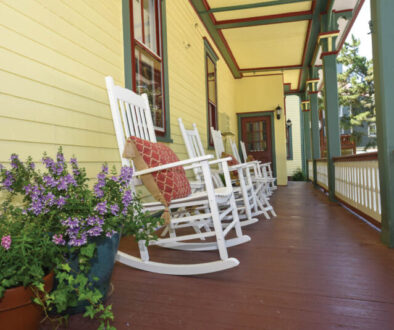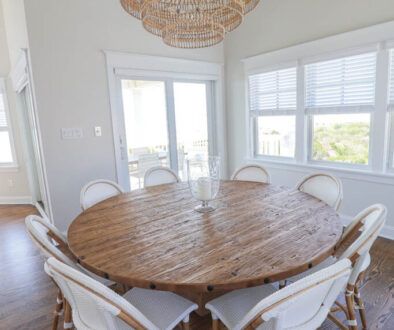Pillars and Presidents
Historic images courtesy of CAPE RESORTS GROUP

This article is Part two of an ongoing series. If you haven’t read part one, click here to do so now!
Cape May has a long rich history, spanning centuries in lockstep with the founding and development of what would become the United States of America. In fact, there is a direct correlation between Cape May and the first day English pioneers set foot on the foreign continent. Though, even before the English arrived, Dutch explorers were the earliest Europeans surveying the shores of New Jersey, which they called New Netherland, evaluating its prospects as a new colony. Those settlers began occupying the area sometime around 1615, more than 150 years before the signing of the Declaration of Independence, which took place just 85 miles north, in Philadelphia.
What began as a maritime outpost eventually became the hub of a regional fishery, primarily dedicated to whaling and clamming. While the fishing industry continues to maintain its position as an integral component of the local economy, over the years commerce on the cape has shifted focus, from a market driven by hard labor to one driven by hard leisure. Quickly, Cape May evolved to become a summer destination for travelers during the formative years of the United States. Initially, it was mostly Philadelphia’s well-to-do families that spurred the interest in Cape May as a place for vacationing, with some of the South’s elite following suit not long thereafter. As a result, the local hospitality industry emerged, albeit from very humble beginnings.
The early days of lodging as a business operation effectively consisted of property owners renting out individual rooms within their own private residences. As it became apparent that more and more people were finding their way to Cape May for extended periods of time, proprietors began developing buildings to accommodate a greater number of transient guests. This contributed to the rise of boarding houses along the Jersey Shore. Among those was “The Big House” – a simple, but large, wood-framed boarding house constructed in 1816. The speculative venture was a product of Thomas Hughes, seeking to capitalize on the booming summer populations. While boastful in name, the practicality of its size drew skepticism from locals. Disbelieving of the building’s potential success, many in the community dubbed the structure “Tommy’s Folly.”

Unfortunately, the original boarding house did not last long enough for a fair assessment, falling victim to fire just two years after it was built. Unwavering amid sweeping societal doubt, with a vision of increased capacity and greater amenities, Hughes doubled down and built its replacement even larger and more luxurious. Aside from the increase in square footage, the new iteration featured significant alterations, as well as an additional wing. Propelled by success and renown as a burgeoning hotelier, Hughes was elected to Congress in 1828. In celebration, he rebranded his establishment “Congress Hall.”
Alas, exactly 60 years after it was constructed, the building was again destroyed by fire in the Great Fire of 1878, when an estimated thirty-five to forty acres of Cape May City was reduced to ash. This tragedy, in the wake of the Great Chicago Fire in 1871, contributed to the conversation regarding the implementation of new building methods to enhance life protection for occupants and safeguard buildings as valuable assets. As a result, the third iteration would be rebuilt, just one year after the fire. However, before breaking ground, a subdivision of the original property created Congress Place and ultimately limited the size of the inevitable reconstruction. This time, the much smaller hotel was constructed of brick and was sited closer to the beachfront. This is the building that stands today. When finished in 1879, Congress Hall stood at the forefront of a new era, in which the grandeur of a hotel represented an elevated tier of hospitality. Quickly, the new establishment became a premier destination for wealthy tourists during the summer season.
To further emphasize the age and importance of all the iterations of Congress Hall, we might take note of significant milestones that could place the development of the building in the context of American History. Through the lens of global history, the United States is still considered a young nation. Though, when we analyze early American cities or buildings, we tend to consider them old. Originally established as Cape Island in 1858, Cape May City was officially incorporated in 1869. Ten years later Congress Hall was built. Though not the first iteration – with earlier structures previously mentioned as having been destroyed by fire – the Congress Hall built in 1879 is in fact the one standing today. This new (present-day) building we are familiar with, although one of the smaller versions, is the one that has hosted some of the most notable events and most renowned guests in Cape May’s history.

Veranda of Congress Hall, 1877.

There have been 46 American presidents since the office was established in 1789 – 80 years before the current Congress Hall was constructed. Coincidentally, there have also been 46 official “Summer White Houses.” Not every president has had an official executive vacation residence. Some had a different accommodation for the summer of each term year. Four former presidents are known to have visited Congress Hall: Franklin Pierce, James Buchanan, Ulysses S. Grant, and Benjamin Harrison. However, Benjamin Harrison was the only president to designate the hotel as his official Summer White House. As such, the hotel became the center of national affairs for several months each year throughout the course of his presidency, from 1889-1892. Around the same time, John Phillip Sousa, American composer/conductor known for his military marches during the late Romantic era, was a regular visitor of Congress Hall with the U.S. Marine Band. Here, Sousa composed the “Congress Hall March” and debuted it to an audience on the sprawling front lawn of the hotel during the summer of 1882.
The building’s L-shaped plan, like other notable Cape May hotels of the time (i.e. Stockton Hotel, Windsor Hotel, etc.), opened toward the Atlantic Ocean and surrounded the south-facing lawn, intended to exploit the sun’s path – a perfect place for a variety of outdoor summer activities. Bordering the north and east edges of the front lawn and wrapping around to the north side of the building, a soaring three-story veranda with a poured concrete floor, which is tinted and stamped to resemble slate tiles, allows for covered circulation around the exterior of the building and permits immense sunlight to enter the building’s interior spaces. The seemingly never-ending colonnade provides a shaded place for patrons to relax and engage in small-town (or big-city) gossip over tea and other libations.

The porch’s white square columns extend to the underside of a large painted wood beam, where they are capped with paired scrollwork brackets. The beam supports the low end of the shallow, black standing-seam metal roof overhead. The bottom of the roof is exposed and feels as high as the summer sun, with structural wood rafters and plank sheathing painted a light shade of grayish blue – an inference of the sky above. The high-end of the porch roof ties into the bottom of a mansard roof that spans transversely across the main building. The main roof is covered in slate roof tiles and punctuated with single and double-wide dormers, which are capped with gable roof lines and feature two-over-two double hung windows.
As previously noted, the exterior walls are composed of brick, set in a common bond pattern. Now painted a pale shade of yellow, the building used to sport a bold red paint finish. The façade displays a rhythmic array of individual four-over-four double hung windows, much taller than those in the mansard dormers, providing expansive ocean views for the hotel guests staying in rooms on the south side of the building, facing the Atlantic. For those same guests, the second-floor level features exterior balconies at regular intervals, two or four bays wide, accessible directly from inside the rooms. The balconies are enclosed with an intricately carved-wood railing, which has been modified with a round metal guardrail to address life-safety concerns. The underside of each balcony is utilized for surface mounted spot lighting to illuminate the veranda floor below. The fenestration at the ground level repeats in the same cadence as that above, though each window is flanked with louvered wooden shutters that are painted black. Those openings are much taller than any of the others – some extending all the way to the floor level and a few featuring doors instead.
Stylistically, a 2008 Historic Preservation Commission survey classified Congress Hall as representing the Second Empire – generally considered a combination of design features from various periods and styles. While the Second Empire includes a number of adaptations, some fundamental characteristics exist. For instance, the buildings are often large and stand alone. Internally, spaces are configured simply along axial paths, while the exterior displays a copious amount of classical detail.
Throughout the years, the building’s aesthetic has been mistakenly described many ways – including Colonial, Federal, Italianate, and Victorian. Unsurprising as it is to hear Cape May buildings described as Victorian, it should be noted that the term actually refers to a period (1830-1910 during the reign of Queen Victoria) and is often confused for a singular style. In 1976, right around the bicentennial anniversary of the country’s founding, Cape May’s Historic District, effectively the entire city, was designated as a National Historic Landmark. Widely acclaimed for its assortment of architectural styles, Cape May’s portfolio of Victorian buildings places the small town in the conversation with San Francisco, regarding the movement popular during the mid-to-late 19th century. Recognized as America’s Original Seaside Resort, Cape May’s compilation of architectural case studies comprises a spectrum of buildings from multiple eras.



Congress Hall is considered a “key building” within the historic district—defined by the Cape May Historic Preservation Commission as “a building, site, structure or object of such outstanding quality and state of preservation that it independently significantly enhances the Historic District’s significance.” Aside from its grandeur, both historically and architecturally, the building is particularly noteworthy due to its status as one of the largest remaining 19th century hotels on Cape May’s beachfront. Approximately 64,000 square feet, Congress Hall is considerably larger than most of the surrounding buildings, which are predominantly single-family residences. The only nearby structure comparable in size today, though still much smaller, is the Regent Beach Condominium building across Congress Street. With its size, the prestigious hotel has demanded a similarly scaled maintenance plan. However, over time, the building fell into a state of disrepair and would require significant construction work to restore the famed hotel to good standing. The first attempt at doing so would take place during the Roaring Twenties, when rooms were enlarged to accommodate new bathrooms, ultimately decreasing the number of rooms by roughly two thirds.
As a key building in the Historic District, Congress Hall is subject to stringent design standards and construction regulations – from local, state, and national authorities having jurisdiction. Paramount among those is the Secretary of the Interior’s Standards for the Treatment of Historic Properties, representing the executive departments of the United States Federal Government. Those guidelines are considered to be common sense historic preservation principles, in non-technical language, that protect historic preservation practices. Specifically, the Secretary of the Interior’s Standards mandate, “new additions, exterior alterations, or related new construction shall not destroy historic materials that characterize the property. The new work shall be differentiated from the old and shall be compatible with the massing, size and scale, and architectural features to protect the historic integrity of the property and its environment. New additions shall be undertaken in such a manner that if removed in the future, the essential form and integrity of the historic property and its environment would be unimpaired.”

Cape Resorts Group consistently makes fine work of maintaining both Congress Hall’s interior and exterior, including the groundskeeping of the nearly two-acre lot. Beyond that, as the hotel and its amenities continue to generate profits, improvements are made to preserve the building’s historic integrity while enhancing the visitors’ experience. A comprehensive overhaul was completed in 2002, following almost seven years of meticulous work, beginning in 1995. At that time, the building envelope and building structure were subject to extensive intervention. Roughly 150,000 units of the brick façade were methodically cleaned and repainted. In areas of severe degradation, bricks would have been replaced in kind, while the joints between were repointed, which includes the removal and replacement of the mortar binding each brick to the next. The underlying original structural frame, composed of heavy timber, was reinforced with roughly 70 tons of steel framing members. Atop the building, approximately 18,000 slate shingles were hand-cut and individually installed to cover the near-vertical surfaces of the mansard roof section. Inside, the building received new finishes, fixtures, and furnishings. All in, the restoration and renovation efforts tallied over $25 million in project costs. Those costs were, in part, subsidized by both state and federal funding, with another $600,000 or so being contributed directly by the City of Cape May. As a result, Congress Hall has regained its place as the premier high-end resort hotel of Cape May, offering a variety of amenities beyond lodging—including spa, retail, café, bars, restaurants, and other unique experiences.
Since the renovation that culminated in 2002, another revamp occurred in 2016, corresponding with the 200th anniversary of the site’s original development as The Big House. At this time, ownership pursued a vision that could not be implemented when money was tight almost two decades earlier. Over one hundred guest rooms were completely renovated and a new in-ground pool was installed in the front lawn, beside which a new accessory building was constructed, accommodating changing rooms and a pool-side bar. Moreover, the annex—a single-story addition to the main L-shaped building—had been refurbished for street-side retail spaces and a bar/restaurant in the basement level, now known as the Boiler Room. To accommodate the presumptive influx of patrons, site improvements also included roughly two hundred new parking spaces at the front of the property, accessed from Beach Drive.

Cape May has evolved significantly since the first Europeans to arrive laid plans for the area in the earliest days of America. As the small city has adapted to its continuous redevelopment, so too have the buildings that have been constructed here. Many structures throughout town have stood the test of time, a great number of which have faced the perilous conditions of fire, flooding, and unrelenting winds. Few, however, have experienced all of those on the front lines of Cape May, like Congress Hall has. Buildings here, including the famed hotel, have responded to those hazards. Many are already designed or retroactively equipped to mitigate fire, calling on centuries of history for lessons learned. Today, homes and commercial buildings are being constructed or renovated (lifted) to respond to the mounting concern of the threats related to sea level rise and storm surge flooding—and inherent risk of coastal development. These fears and subsequent responsive construction methods are beginning to change the dynamics of Cape May’s built environment. Furthermore, with a recent boom in real estate and construction, a greater number of buildings is being erected, often with a less enchanting contribution to Cape May’s compendium of architecture character.
Nevertheless, Congress Hall remains a stalwart. Presiding over the beachfront, prominently situated on its appropriate high ground, the former “summer White House” is steadfast when facing the challenge of remaining relevant amid constant change. The resort hotel is a showpiece for Cape May’s collection of treasured buildings. And, while Congress Hall has certainly been modified and modernized to accommodate the transient guests and local patrons of the 21st Century, it has been uncompromising when it comes to the maintenance of its historic integrity. Congress Hall is certainly a relic of the past, but is also an icon of the present-day —serving, in both cases, as a model of luxurious hospitality, high design, and historic preservation. ■



